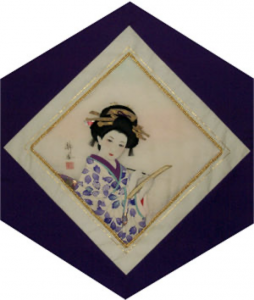Japan

The Block
A portrait of a graceful woman, peacefully painting while dressed in a customary kimono, is the theme of the Japan block. This lovely scene, produced entirely in silk, was created by Sayoh Yabu through a three dimensional textile art technique called Oshie (oh-shee-ay). This technique involves folding small pieces of the fabric to produce a 3-dimensional image. The Japanese design aesthetic is asymmetrical yet perfectly balanced, always embodying a sophisticated simplicity that delicately balances colour, form and line. Over her right shoulder, the artist’s name is finely hand painted onto a soft background of billowing white and pale pink clouds. A double strand of gold braiding surrounds the piece which was then edged in fine Japanese gold work.
Cultural Profile
An island nation, Japan is called Nippon by its inhabitants, which means ‘origin of the sun.’ It is a country of many contrasts such as the rugged grandeur of its mountains, the peaceful beauty of its rock gardens, the fierce samurai or the delicate geisha. The Japanese language is sensitive to social relationships, with different degrees of politeness and familiarity used dependant on factors such as social status, age and gender.
The country is one of the most homogeneous in the world with less than two percent of the population being non-Japanese. The first contact with European navigators was established in the 15th century, but by 1639, Sakoku measures were put in place. According to these measures, it was forbidden for outsiders to enter Japan, or for the Japanese to leave the country. This policy lasted until the 19th century, after which Western influence was allowed. Nonetheless, Japan’s unique culture remained the core of society. Children are taught at an early age that being part of a group is more important than individuality because the family is the basis of society. Inappropriate public behaviour reflects poorly on the family and society in general. Rules must be followed, based on traditions of honour, loyalty and the importance of saving face.
Japan is an important center for textile art. Silk has been produced in the country since the 4th century AD, when silk worms were introduced from China. Fine silk brocades, gauzes, batiks and damasks were produced. The country’s iconic garment, the kimono, is also made of silk, often ornamented with exquisite designs and embroidery. The obi, the sash worn over a kimono, also comes in a wide variety of colour and designs with the Nishijin-ori obis, made of silk brocade, being highly prized.
Japan has developed some unique techniques for producing striking and unusual silk fabric. In Saga-nishiki, the warp is made of paper coated with gold, silver or lacquer, and the weft is silk, creating rich effects. A silk art known as Yuzen, involves using rice paste to do resist-dyeing. Kimonos produced using this method are very valuable. Tsumugi is a type of hand-spun silk done in different areas of Japan, each following local practices. For example, in the city of Yuki, a tie-dye technique is used where each fiber is hand-dyed before being woven into a soft fabric. Kasuri cotton fabric uses indigo dyeing for both weft and warp. This natural dye is also used in the making of shibori, another tie-dye tradition. The fibers of the ramie plant, which can grow up to 2.5 m tall, are used to make a light and moisture-resistant fabric called aoso, while the fibers of the Japanese banana plant are woven into the bashōfua fabric, on the island of Okinawa.
Japanese are also known for a wide range of arts and crafts, apart from textiles. These include the three-line haiku poetry, kabuki, a humorous style of moral-lesson theatre performed by men, and ikebana, the art of flower arranging in which the flowers symbolize heaven, earth and humanity. Bonsai, the art of miniaturizing trees or plants and calligraphy are also popular.
In 1877, Manzo Nagano was the first Japanese to come to Canada. A strong sense of community exists for the Japanese now living here, thanks to the many organizations, language schools, credit unions, trade associations and friendship groups that have been formed. As of 2011, there were 109,000 people of Japanese ancestry in Canada.
Sponsor: Embassy of Japan
